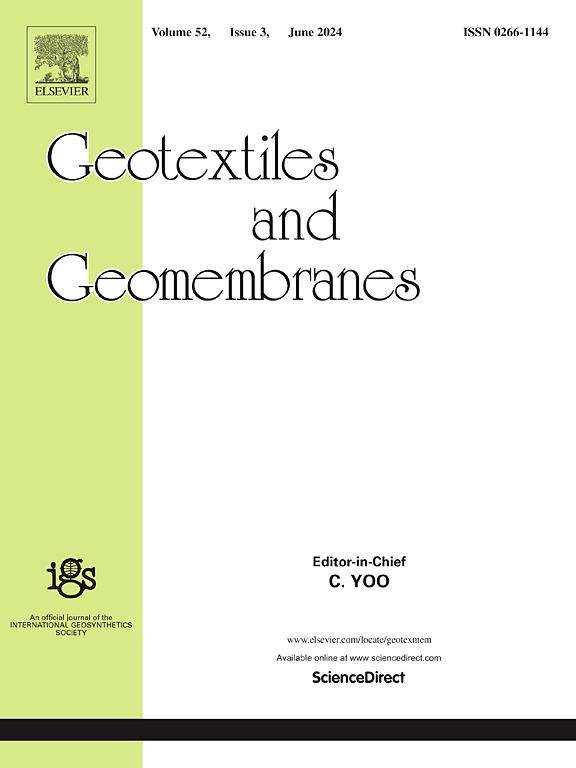Development and application of a nonlinear stress dilatancy model for geocell-reinforced soil via the FEM
IF 6.2
1区 工程技术
Q1 ENGINEERING, GEOLOGICAL
引用次数: 0
Abstract
To address the ambiguities in current ontological models of geocell-reinforced soil and the limitations inherent in finite element analysis methods, a nonlinear stress dilatancy model (NSDM) encompassing geocell-reinforced soil was successfully formulated. This model is based on the interaction between the geocell and the infilled soil, which can consider the confining pressures provided by the geocells and the stress dilatancy model of the soil. A finite element method (FEM) implementation of the model was achieved via the User-defined Material (UMAT) subroutine interface provided by ABAQUS software. Validation of the model was achieved via triaxial tests on geocell-reinforced sand with varying relative densities, as well as reinforced foundation and retaining wall model tests. Concurrently, the model calculation results were compared and analyzed with those obtained from a conventional separated model, and an in-depth exploration of the sensitivity of the model's key parameters was carried out. The findings demonstrate that the UMAT subroutine of the model can accurately predict the reinforced sand triaxial test, the reinforced foundation model test and the retaining wall model test results. Compared with the reinforced soil-separated model, the model delineated in this paper is easier to construct and has markedly improved computational efficiency. Additionally, the model can capture failure within the geocell fill, thereby affording a more precise depiction in the near-failure stage. This research offers an efficient and practical novel methodology for numerical analysis within the domain of geocell-reinforced soil.
基于有限元的土工格室加筋土非线性应力剪胀模型的建立与应用
针对目前土工格室加筋土本体模型的模糊性和有限元分析方法的局限性,建立了包含土工格室加筋土的非线性应力剪胀模型(NSDM)。该模型建立在土工格室与填土相互作用的基础上,考虑了土工格室提供的围压和土的应力剪胀模型。通过ABAQUS软件提供的用户自定义材料(UMAT)子程序接口实现了模型的有限元法实现。通过不同相对密度土工格室加筋土的三轴试验,以及加筋土基础和挡土墙模型试验,验证了该模型的有效性。同时,将模型计算结果与常规分离模型计算结果进行了对比分析,并对模型关键参数的敏感性进行了深入探讨。结果表明,该模型的UMAT子程序能较准确地预测加筋砂三轴试验、加筋地基模型试验和挡土墙模型试验结果。与分筋模型相比,本文所建立的模型更易于构建,计算效率显著提高。此外,该模型可以捕获土工格室填充中的失效,从而在接近失效阶段提供更精确的描述。本研究为土工格室加筋土的数值分析提供了一种高效实用的新方法。
本文章由计算机程序翻译,如有差异,请以英文原文为准。
求助全文
约1分钟内获得全文
求助全文
来源期刊

Geotextiles and Geomembranes
地学-地球科学综合
CiteScore
9.50
自引率
21.20%
发文量
111
审稿时长
59 days
期刊介绍:
The range of products and their applications has expanded rapidly over the last decade with geotextiles and geomembranes being specified world wide. This rapid growth is paralleled by a virtual explosion of technology. Current reference books and even manufacturers' sponsored publications tend to date very quickly and the need for a vehicle to bring together and discuss the growing body of technology now available has become evident.
Geotextiles and Geomembranes fills this need and provides a forum for the dissemination of information amongst research workers, designers, users and manufacturers. By providing a growing fund of information the journal increases general awareness, prompts further research and assists in the establishment of international codes and regulations.
 求助内容:
求助内容: 应助结果提醒方式:
应助结果提醒方式:


